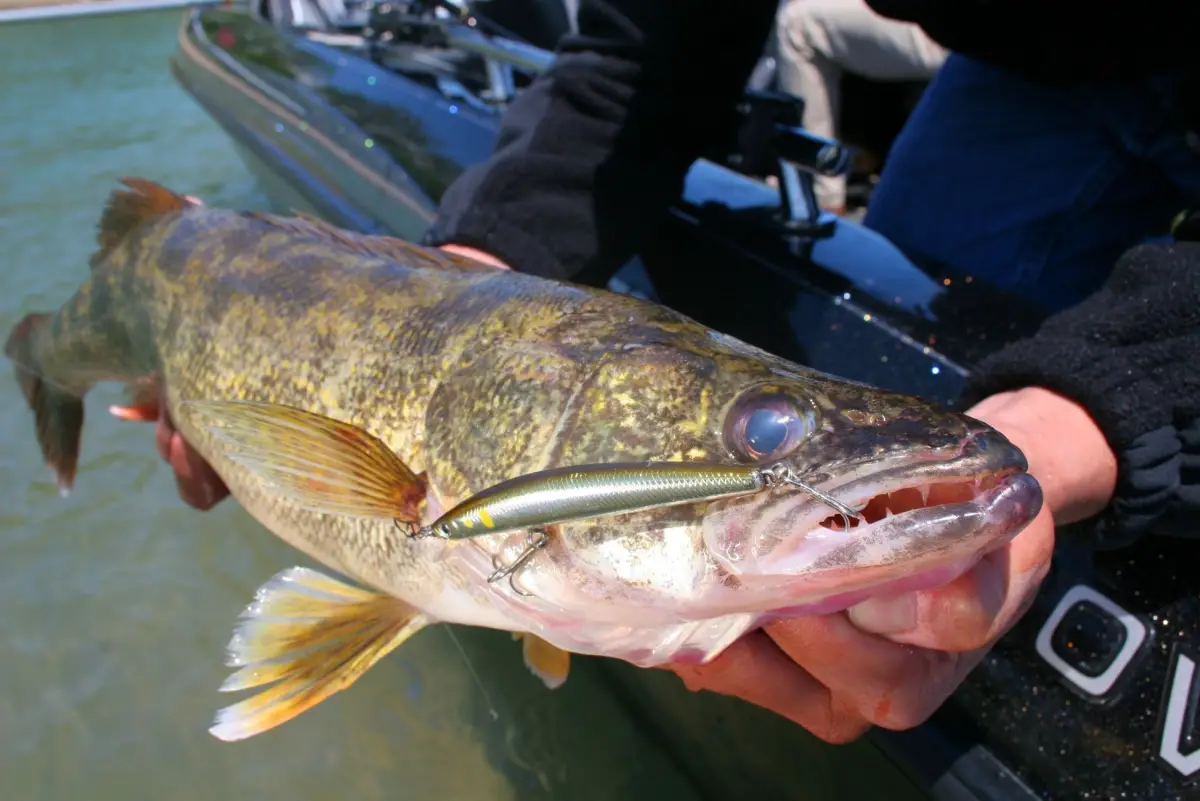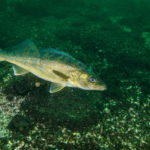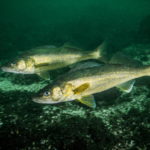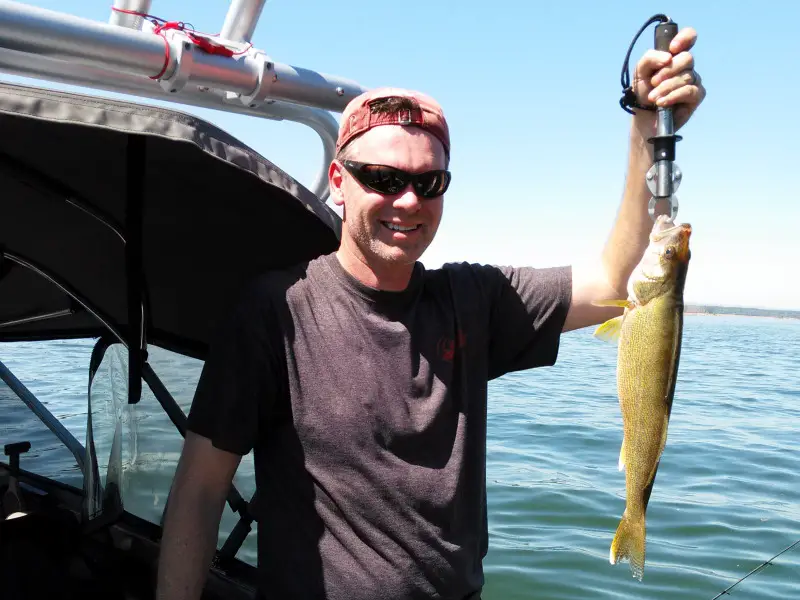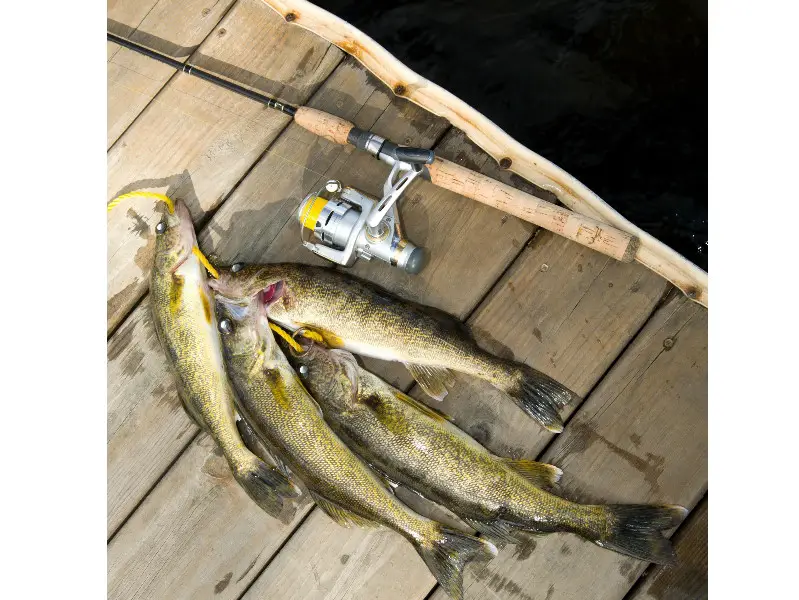You feel a tug on your line and you quickly reel in, joyful about your fishing success. This joy soon turns to confusion as you find you reeled in an odd, glassy-eyed fish. Your catch is neither blind nor a mutant – it’s simply a walleye!
Walleye are usually golden across their upper body, and their last two spines are normally solid black. Walleye have white underbellies, and the lower tips of their tails are also white. Most apparent are walleye’s glassy eyes, which make them appear blind to the untrained eye.
While looks can be deceiving, specific features of walleye can make them fairly easy to spot if you know what you’re looking for. Continue reading to learn more about a walleye’s features and what they mean for its survival.
What Does a Walleye Look Like?
In general, most walleye are gold/olive colored on their sides, with white underbellies. In addition to this, they often have two black spines on their back, and the bottom portion of their tail is often colored white. Lastly, their eyes are normally white and glassy.
Walleye can be a varied species, often looking different depending on where you see them. Geographic differences can create harsh contrasts between the fish.
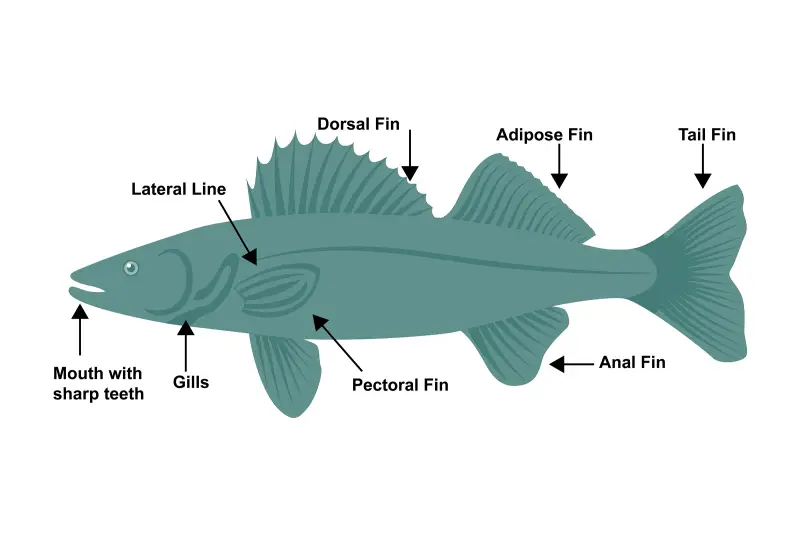
However, basic features for most walleye include:
Coloration
Walleye usually have yellow/silver sides, with black tops and white underbellies. Along with this, they are noted for having their last two dorsal spines white in color and having a white patch on the bottom of their tails.
Shape and Size
At maximum weight/size, walleye can reach a weight of 20 pounds (9 kg) and a length of 3 feet (0.9 m) on average. This is a maximum, but they can range from area to area; one example of this is in Ohio, where the state record is only 16 pounds (7.25 kg).
Eyes
Probably the most distinctive feature of walleye in their eyes. All walleye have white and glassy eyes that make them look as if they are blind. However, their eyes are incredibly useful to their survival and give them an advantage in dark waters.
What Do All These Features Mean?
The distinctive features of the walleye are adaptations meant to help them survive in their natural habitat. Walleye look slightly different depending on where they are located, but their characteristics, such as sharp teeth and glassy eyes, help them navigate their surroundings and avoid predators.
Walleye Use Their Size, Shape, and Teeth To Hunt Prey
The comparably large shape and size of the walleye mean that it is a powerful swimmer, allowing it to get away from larger predators while also hunting down fast prey. Walleye also have larger, pointed teeth that can help them latch onto prey.
Their Eyes Enable Them To Hunt Prey at Night
Their glossy eyes provide walleye one of their biggest advantages in hunting. The white/glossy portion of the eye is due to a reflective layer called the tapetum lucidum (also found in other animals such as cats and cows). This layer helps reflect light in the eye, allowing them to see better at night.
This improved night vision gives them an upper hand on hunting, enabling them to attack unsuspecting prey that cannot see at night.
How Many Species of Walleye Exist?
Only one species of walleye exists. While it may seem as though the different characteristics among walleye from different locations set them apart, most scientists agree that these are minimal (even on a DNA level), and make all walleye part of the same species.
Origins of Walleye Species
All walleye are believed to have descended from other fish, such as the blue pike, although scientists now believe that blue pike and walleye are eerily similar themselves.
Walleye belong to the Percidae family. This family is known for being the “perch” family, including fish such as yellow-perch and sauger.
Walleye (from all over the U.S.) have the same scientific name, Sander vitreus.
Where Are Walleye Located?
Walleye are native to and located in the global North, including parts of Canada and the U.S. There are small pockets throughout the region where you’re guaranteed to find walleye, often in lakes and river basins.
Canadian Walleye
In general, walleye are most easily found in Canada. They are often said to be found in most habitable bodies of water.
Most sources also say that Ontario is a large hub for walleye fishing. One main location many fisheries quote for being a great walleye spot is the Bay of Quinte.
American Walleye
While still abundant, American walleye are a bit more limited in their location across the country. In the U.S., walleye have very specific pockets of high populations in certain rivers and lakes.
One of the most apparent is the Great Lakes. While they can be wild here, walleye are often so popular that they are stocked near the area.
Other than the Great Lakes, walleye can easily be found in the Missouri River Basin (both upper and lower).
As walleye are becoming more popular, they are starting to be found and introduced into other areas of America, such as the Western and Northeastern regions.
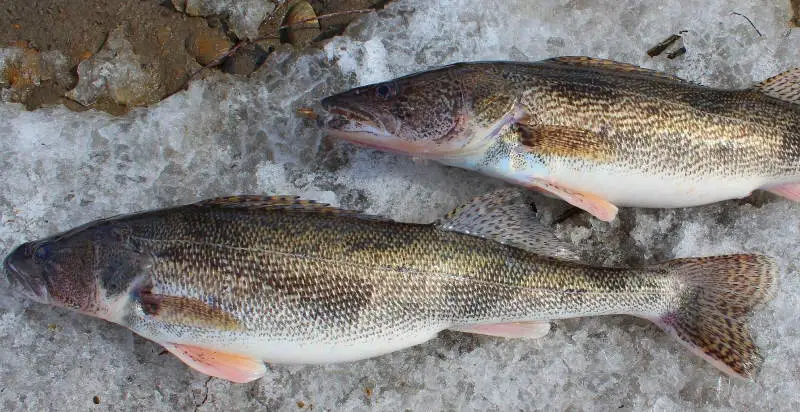
Common Mistakes in Identification
Walleye can look vastly different from each other across their range. These differences make it challenging to know if one walleye is the same species as another you saw somewhere else. Walleye also have many common and specific similarities to other species.
Differences in Regional Walleye
As mentioned, walleye can vary slightly in appearance from region to region. This normally occurs simply in coloration, where some can appear more yellow and others could look more blue or green.
This is a minute distinction, but it was once enough to have the scientific community deem differently-colored walleye as separate species (until more research was conducted).
Sauger Are Often Mistaken as Walleye
Walleye and sauger can often live in the same locations, and can even crossbreed. Similar to walleye, saugers also have dark blotches, white lower tails and are comparable in shape and size. Saugers have spotted dorsal fins and are generally smaller than walleye.
Yellow Perch Bear a Resemblance to Walleye
Like walleye and sauger, yellow perch are also in the Percidae family, and often inhabit the same waters. On the other hand, this fish is less similar to the other two (although it can still be misidentified as a walleye).
Like the walleye, yellow perch also have dark blotches on their backside, and a similar shape and size. One easy way to distinguish this fish from a walleye is that they are often slightly smaller and have brighter yellow areas on the sides (and sometimes on the underbelly).
It may seem confusing to pick apart walleye from other species of fish, or even walleye from other walleye, but there are some tools that you can use to distinguish them. Many advanced fishers collect identification books or go to online fish identification apps.
Conclusion
Walleye are intriguing fish and look very similar to other species, which can make them challenging to identify. However, because walleye is a good table fare they have become very popular.
There are a few walleye characteristics that distinguish them from other fish, including:
- Silvery-yellow sides
- White underbellies
- White, glassy eyes
- Black lines across the back
- Back spines (with the two last spines being black in color)
- White bottom portion of the tail
Many other fish species are often mistaken for walleye. But no other fish has all of these characteristics, making this list a great tool for knowing what a walleye truly looks like.
Check out our article Are Walleye Line Shy?
